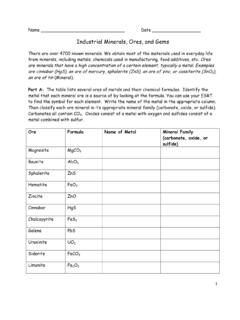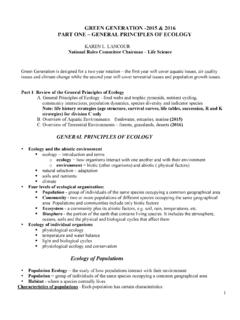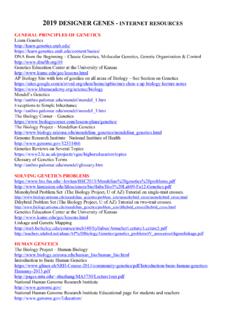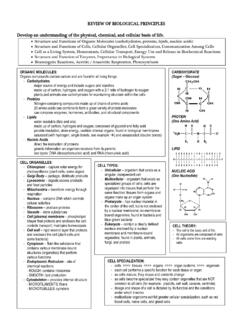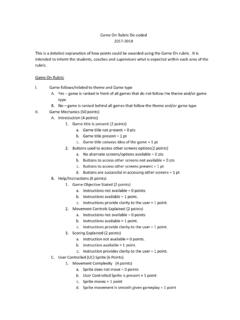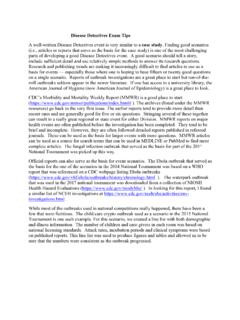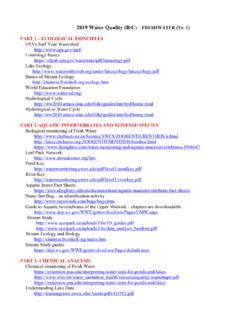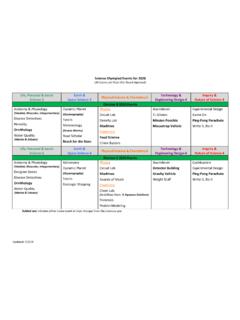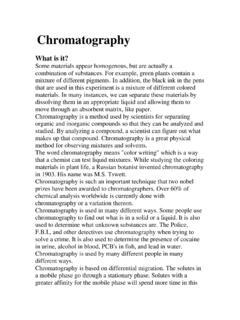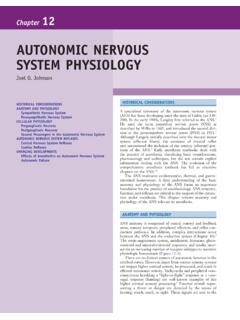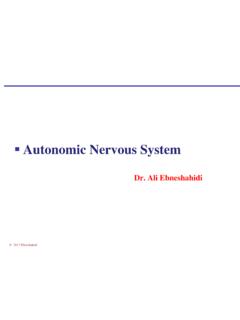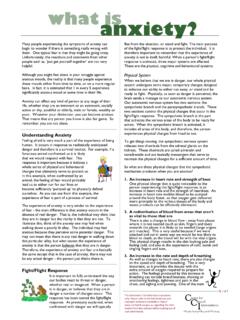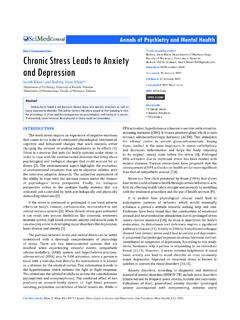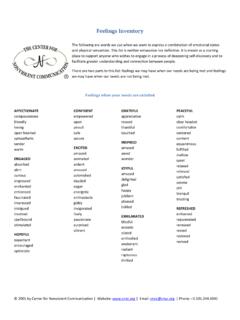Transcription of The Nervous System
1 The Nervous System Functions of the Nervous System 1. Gathers information from both inside and outside the body - Sensory Function 2. Transmits information to the processing areas of the brain and spine 3. Processes the information in the brain and spine Integration Function 4. Sends information to the muscles, glands, and organs so they can respond appropriately Motor Function It controls and coordinates all essential functions of the body including all other body systems allowing the body to maintain homeostasis or its delicate balance. The Nervous System is divided into Two Main Divisions: Central Nervous System (CNS) and the Peripheral Nervous System (PNS). Divisions of the Nervous System 1. Basic Cells of the Nervous System Neuron Basic functional cell of Nervous System Transmits impulses (up to 250 mph). Parts of a Neuron Dendrite receive stimulus and carries it impulses toward the cell body Cell Body with nucleus nucleus & most of cytoplasm Axon fiber which carries impulses away from cell body Schwann Cells- cells which produce myelin or fat layer in the Peripheral Nervous System Myelin sheath dense lipid layer which insulates the axon makes the axon look gray Node of Ranvier gaps or nodes in the myelin sheath Impulses travel from dendrite to cell body to axon Three types of Neurons o Sensory neurons bring messages to CNS.
2 O Motor neurons - carry messages from CNS. o Interneurons between sensory & motor neurons in the CNS. Impulses A stimulus is a change in the environment with sufficient strength to initiate a response. Excitability is the ability of a neuron to respond to the stimulus and convert it into a nerve impulse All of Nothing Rule The stimulus is either strong enough to start and impulse or nothing happens Impulses are always the same strength along a given neuron and they are self-propagation once it starts it continues to the end of the neuron in only one direction- from dendrite to cell body to axon The nerve impulse causes a movement of ions across the cell membrane of the nerve cell. Synapse o Synapse - small gap or space between the axon of one neuron and the dendrite of another - the neurons do not actually tough at the synapse o It is junction between neurons which uses neurotransmitters to start the impulse in the second neuron or an effector (muscle or gland).
3 O The synapse insures one-way transmission of impulses Neurotransmitters Neurotransmitters Chemicals in the junction which allow impulses to be started in the second neuron 2. Reflex Arc Components of a Reflex Arc A. Receptor - reacts to a stimulus B. Afferent pathway (sensory neuron) - conducts impulses to the CNS. C. Interneuron - consists of one or more synapses in the CNS (most are in the spine). D. Efferent pathway (motor neuron) conducts impulses from CNS to effector. E. Effector - muscle fibers (as in the Hamstring muscle) or glands responds by contracting or secreting a product. Spinal reflexes - initiated and completed at the spinal cord level. Occur without the involvement of higher brain centers. Central Nervous System Brain o Brain stem medulla, pons, midbrain o Diencephalon thalamus & hypothalamus o Cerebellem o Cerebrum Spine o Spinal Cord Meninges Meninges are the three coverings around the brain & spine and help cushion, protect, and nourish the brain and spinal cord.
4 Dura mater is the most outer layer, very tough arachnoid mater is the middle layer and adheres to the dura mater and has weblike attachments to the innermost layer, the pia mater pia mater is very thin, transparent, but tough, and covers the entire brain, following it into all its crevices (sulci) and spinal cord cerebrospinal fluid, which buffers, nourishes, and detoxifies the brain and spinal cord, flows through the subarachnoid space, between the arachnoid mater and the pia mater 3. Regions of the Brain Cerebellum coordination of movement and aspects of motor learning Cerebrum conscious activity including perception, emotion, thought, and planning Thalamus Brain's switchboard filters and then relays information to various brain regions Medulla vital reflexes as heart beat and respiration Brainstem medulla, pons, and midbrain (involuntary responses) and relays information from spine to upper brain Hypothalamus involved in regulating activities internal organs, monitoring information from the autonomic Nervous System , controlling the pituitary gland and its hormones, and regulating sleep and appetite Cerebrum Is the largest portion of the brain encompasses about two-thirds of the brain mass - It consists of two hemispheres divided by a fissure corpus callosum It includes the cerebral cortex, the medullary body, and basal ganglia cerebral cortex is the layer of the brain often referred to as gray matter because it has cell bodies and synapses but no myelin o The cortex (thin layer of tissue) is gray because nerves in this area lack the insulation or white fatty myelin sheath that makes most other parts of the brain appear to be white.
5 O The cortex covers the outer portion ( to 5mm) of the cerebrum and cerebellum o The cortex consists of folded bulges called gyri that create deep furrows or fissures called sulci o The folds in the brain add to its surface area which increases the amount of gray matter and the quantity of information that can be processed Medullary body is the white matter of the cerebrum and consists of myelinated axons o Commisural fibers conduct impulses between the hemispheres and form corpus callosum o Projection fibers conduct impulse in and out of the cerebral hemispheres o Association fibers conduct impulses within the hemispheres Basal ganglia masses of gray matter in each hemisphere which are involved in the control of voluntary muscle movements 4. Lobes of the Cerebrum Frontal motor area involved in movement and in planning &. coordinating behavior Parietal sensory processing, attention, and language Temporal auditory perception, speech, and complex visual perceptions Occipital visual center plays a role in processing visual information Special regions Broca's area located in the frontal lobe important in the production of speech Wernicke's area comprehension of language and the production of meaningful speech Limbic System a group of brain structures (aamygdala, hippocampus, septum, basal ganglia, and others) that help regulate the expression of emotions and emotional memory Brain Waves Brain waves are rhythmic fluctuation of electric potential between parts of the brain as seen on an electroencephalogram (EEG).
6 To measure brain waves electrodes are placed onto the scalp using the EEG. There are four types of brainwaves: o Beta o Alpha o Theta o Delta 5. Peripheral Nervous System Cranial nerves 12 pair Attached to undersurface of brain Spinal nerves 31 pair Attached to spinal cord Somatic Nervous System (voluntary). Relays information from skin, sense organs & skeletal muscles to CNS. Brings responses back to skeletal muscles for voluntary responses Autonomic Nervous System (involuntary). Regulates bodies involuntary responses Relays information to internal organs Two divisions o sympathetic Nervous System in times of stress Emergency response Fight or flight o Parasympathetic Nervous System when body is at rest or with normal functions Normal everyday conditions 6. Major Sense Organs Sensation and perception Vision Eye Hearing Ear Taste Taste receptors (new). Smell Olfactory System Skin Hot, cold, pressure, pain Sense Organs Eye the organ used to sense light Three layers.
7 1. Outer layer consists of sclera and cornea 2. Middle layer consists of choroid, ciliary body and iris 3. Inner layer consists of retina Functions of the major parts of the eye: Sclera or Scleroid Layer (white of eye) a tough protective layer of connective tissue that helps maintain the shape of the eye and provides an attachment for the muscles that move the eye Cornea - the clear, dome-shaped part of the sclera covering the front of the eye through which light enters the eye Anterior Chamber a small chamber between the cornea and the pupil Aqueous Humor - the clear fluid that fills that anterior chamber of the eye and helps to maintain the shape of the cornea providing most of the nutrients for the lens and the cornea and involved in waste management in the front of the eye Choroid Layer - middle layer of the eye containing may blood vessels Ciliary Body - the ciliary body is a circular band of muscle that is connected and sits immediately behind the iris- produces aqueous humor, changes shape of lens for focusing.
8 And Iris - the pigmented front portion of the choroid layer and contains the blood vessels - it determines the eye color and it controls the amount of light that enters the eye by changing the size of the pupil (an albino only has the blood vessels not pigment so it appears red or pink because of the blood vessels). Lens - a crystalline structure located just behind the iris - it focuses light onto the retina Pupil - the opening in the center of the iris- it changes size as the amount of light changes (the more light, the smaller the hole). Vitreous - a thick, transparent liquid that fills the center of the eye - it is mostly water and gives the eye its form and shape (also called the vitreous humor). Retina - sensory tissue that lines the back of the eye. It contains millions of photoreceptors (rods for black & white and cones for color ) that convert light rays into electrical impulses that are relayed to the brain via the optic nerve Optic nerve - the nerve that transmits electrical impulses from the retina to the brain Common eye defects include myopia or nearsightedness where the eyeball is too long or the cornea is too steep; hyperopia or far sightedness where the eyeball is short or lens cannot become round enough: cataracts where the lens becomes fogged; presbyopia where the muscles controlling the bulging of the lens become weak as we age; nyctalopia or night blindness where vision is impaired in dim light and in the dark due to pigment rhodospin in the rods not functioning properly 7.
9 Images the cornea and the lens help to produce the image on the retina images formed by the lens are upside down and backwards when they reach the retina two types of receptors on the retina Rods 125 million on a single retina extremely sensitive to all wavelengths of visible light but do not distinguish different color in dim light only rods are activated where one can see objects but not as sharp images and are not able to distinguish their color most dense in peripheral view nighttime vision Rods have a pigment called rhodospin As amount of light increases, the cones 7 million on a single retina mainly in central view are stimulated and the color becomes clear daytime vision There are three types of cones which distinguish the three colors blue, red, green Fovea point of central focus great density of cones - center of the eye's sharpest vision and the location of most color perception - the layers of the retina spread aside to let light fall directly on the cones Light stimulates rods and cones and sends impulse via optic nerve to brain areas for vision The Optic Nerve exits the eye just off center near the Fovea - the Optic Nerve exits is referred to as the Blind Spot due to the lack of the receptors in this area The two Optic Nerves come together at the Optic Chiasm located just under the hypothalamus - a crucial part of vision and perception must happen - cross-over of information from the right eye crosses over to the left side and visa versa happens here at the Optic Chiasm Information from each eye must be processed in both halves of the brain Information leaves the chiasm via the optic tract.
10 Reorganized optic tract leaves the Optic Chiasm and passes onto the lateral geniculate nucleus At the lateral geniculate nuclei the information is separated, organized, and relayed to different areas of the visual cortex The different zones of the visual cortex process the different aspects of vision and information, taken from both visual fields, is processed and an image is perceived . 8. EAR. Outer Ear & ear canal brings sound into eardrum Eardrum vibrates to amplify sound & separates inner and middle ear Middle ear has 3 small bones or Ossicles = anvil, stirrup, stapes amplify sound (small bones) which vibrate sound Eustachian tube connects middle ear to throat and equalizes pressure on eardrum Cochlea in inner ear has receptors for sound & sends signals to brain via Auditory Nerve Process of hearing: Sound waves enter your outer ear and travel through your ear canal to the middle ear.
